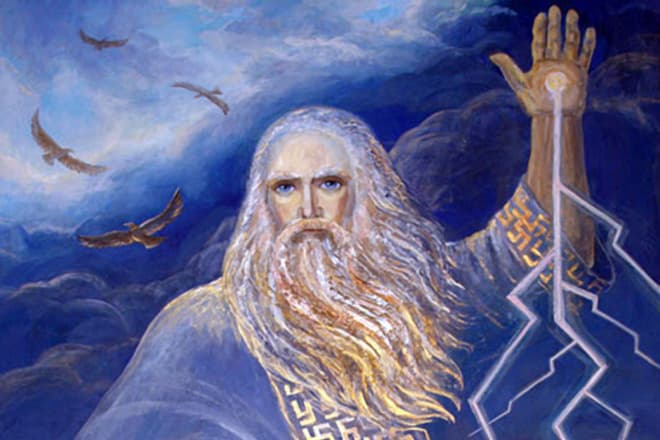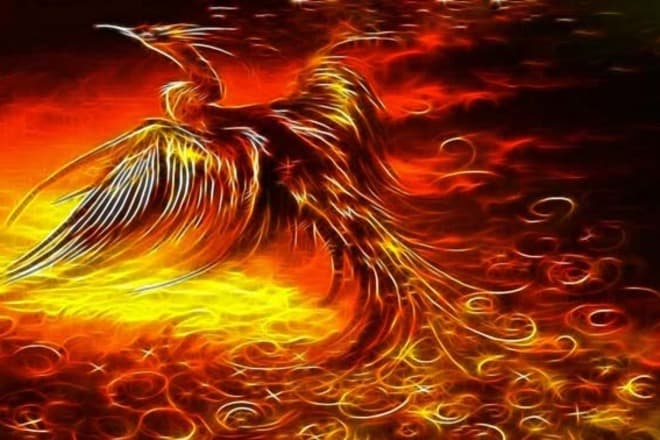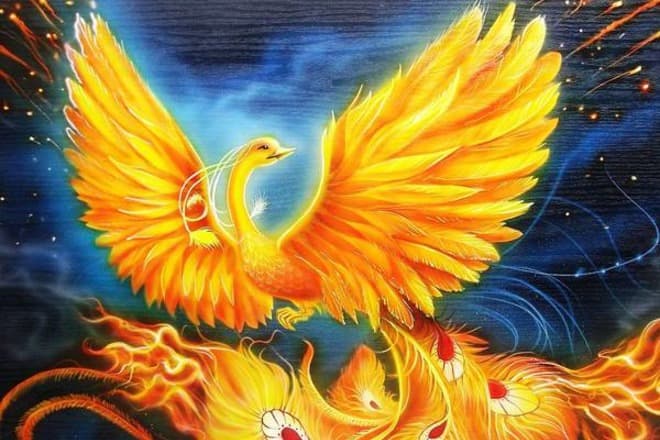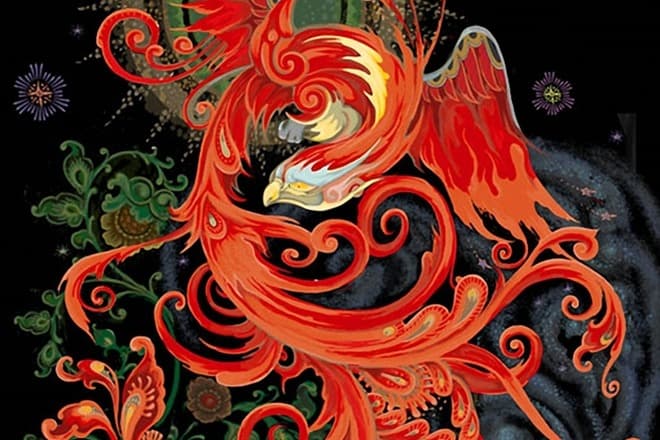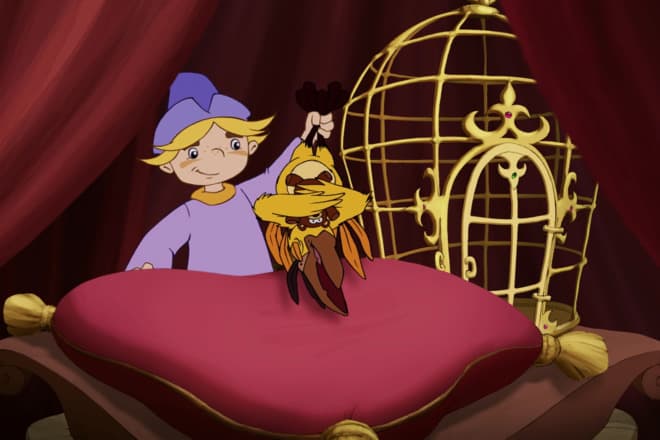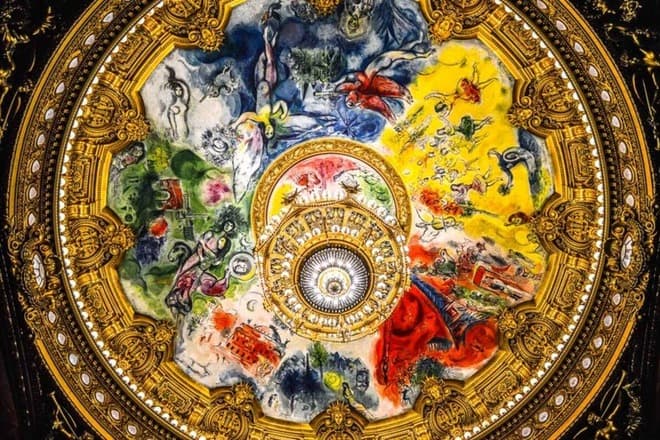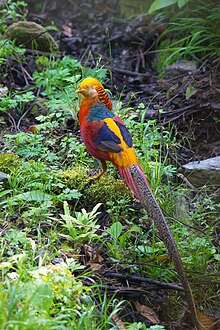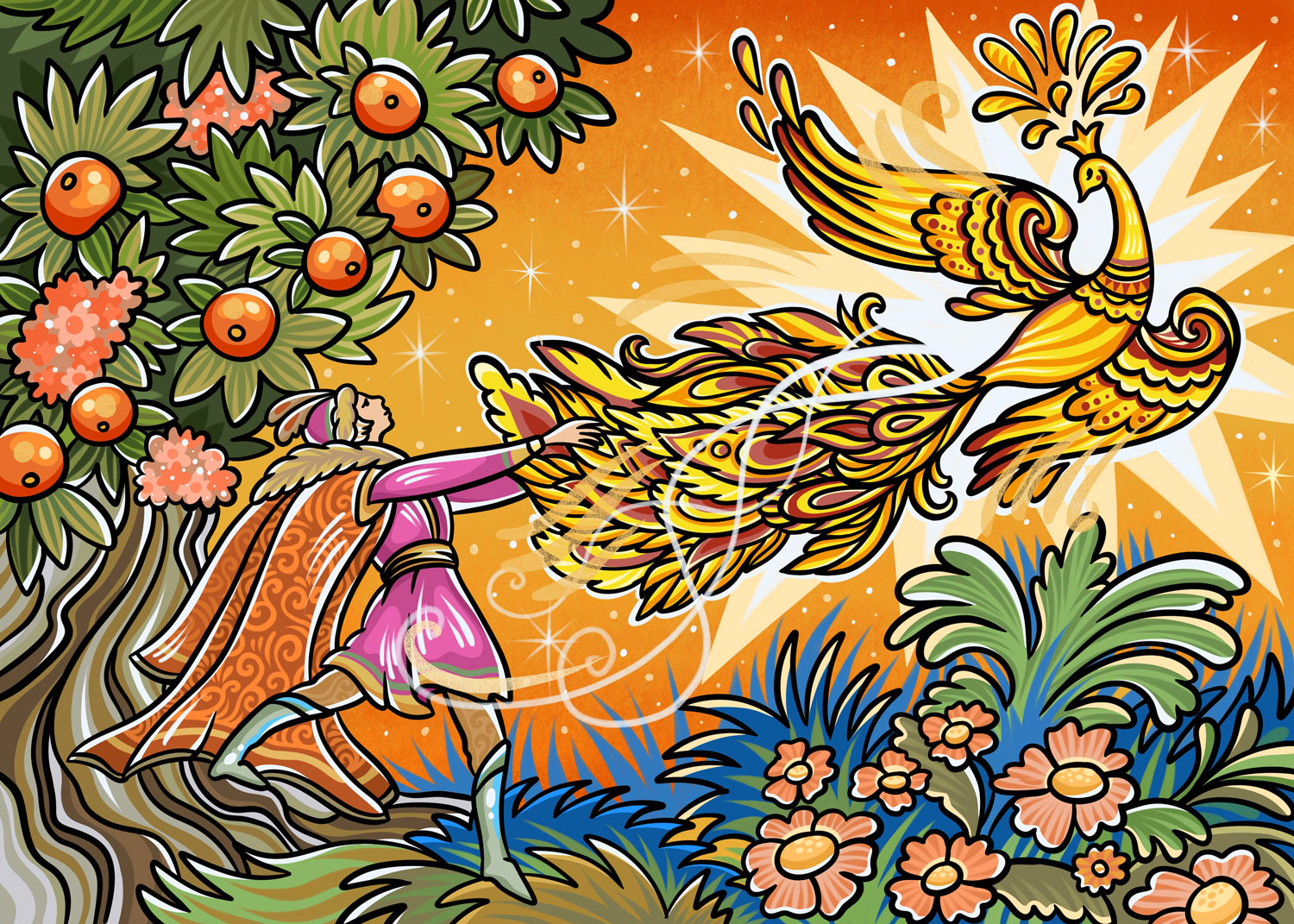История персонажа
Русские народные сказки знакомят читателя с волшебными созданиями, обладающими невероятными способностями и любопытной биографией. Среди таких персонажей – Чудо-Юдо, Конек-Горбунок и Жар-птица. Миф о последней увлекателен, так как схож с легендой о птице Феникс, известной по мифологии зарубежных стран. Внешним обликом птица напоминает павлина. Сама пернатая среднего размера, а ее туловище украшает шикарный хвост размером с павлиний.
История происхождения
Жар-птица – воплощение сказки, олицетворение Бога, покровительствующего грозе и грому. Повелитель молний Перун является в ее обличье, прилетая из тридесятого царства, жители которого поголовно богачи. Земли там несказанно плодородны, а люди не знают нужды, поэтому у птицы золотой окрас – символ благополучия.
Славяне верили, что там же обитают представители божественного пантеона. Изобилие и безмятежность – ценность тех блаженных мест, плоды местных деревьев даруют дополнительные годы жизни, а вода обладает животворящей силой.
По легенде, невиданное существо кушает молодильные яблоки, несущие вечную молодость, бессмертие и привлекательность, и пьет живую воду. Волшебные песни Жар-птицы сопровождаются появлением молний и жемчуга из ее клюва. Хвост пернатой состоит из перьев, сияющих ярким светом.
Она – воплощение огня, поэтому в темное время суток свет от ее хвоста заменяет тысячи источников освещения. Передохнуть от изнуряющих перелетов птица может в золотой клетке. Поймать перо Жар-птицы мечтают смелые герои, верящие, что такой амулет приносит счастье и удачу.
Мифология
Считается, что Жар-птица принадлежит к той же стае, что и Феникс, Финист — Ясный сокол, Рарог. Все эти птицы – представители светлой стороны. Они излучают добро и тепло. Витающие в облаках волшебные создания отличаются праздностью, им нет дела до мирских проблем. Единственное, что занимает их, – это распевание песен.
Будучи птицей, создание относится к воздушной стихии. Но, олицетворяя огонь, имеет отношение и к нему. По легенде, Ирий был местом происхождения персонажа. Мир сказок таит опасность для существ с необычными способностями. Путешествуя по разным краям, Жар-птица иногда оказывалась в плену у героев вроде Кощея Бессмертного. Ее нередко брали в плен, чтобы привлечь в жизнь удачу.
Вольнолюбивая героиня, Жар-птица часто появляется в садах. Золотая клетка – нелюбимое место птицы, привыкшей к простору и полетам. Она боязлива и недоверчива, как любая птица, но крайне любопытна.
Наши предки верили, что Жар-птица исцелит от недугов и подарит долгие годы тому, кто верит в нее и слушает ее пение. Поняв, что наскучила владельцу, она покидает его, переставая дарить свою магию и песни. Желчь существа способна излечить болезни глаз. По легенде, горящее перо птицы излучает свет и тепло. Погаснув, оно становится золотым.
Птица почти ничего не боится, ведь она бессмертна. Завладеть ею без секретных уловок невозможно – она излучает жар и способна ранить. Сказочные герои умудряются завладеть птицей, положив в клетку ее любимое лакомство – яблоки. Трех плодов достаточно, чтобы Жар-птица обратила внимание на ловушку.
Образ Жар-птицы описан в сказках «Иван-Царевич и Серый волк», «Жар-птица и Василиса-царевна», «Конек-Горбунок» и т.д.
Экранизации
Владимир Самсонов выпустил мультфильм о Жар-птице в 1984 году. История, рассказанная постановщиком, не отличалась от сюжета сказки Алексея Толстого об Иване-Царевиче и ловле Жар-птицы.
Вацлав Ворличек снял в 1997 году фильм под названием «Жар-птица». В картине чешского производства вместо Кощея появился злодей Скелетон, Ивана-царевича сменил принц Афрон, а Жар-птица воплощена при помощи картинок. Она появилась в нескольких кадрах и присутствовала в ленте номинально.
Современный мир сказки, с которым знакомятся российские дети, сильно отличается от советского. Режиссеры Георгий Гитис и Вячеслав Плотников в 2013 году выпустили мультфильм «Как поймать перо Жар-птицы», главным действующим лицом которого стал Иван-царевич.
Интересные факты
- В 1984 году на телеэкран вышел фильм-балет «Жар-птица» на музыку Игоря Стравинского. Сюжет о птице, олицетворяющей Бога солнца, очень популярен в театре. Премьера состоялась в далеком 1910 году в хореографии Михаила Фокина. В первом балете партию Жар-птицы танцевала Тамара Карсавина.
- В 1994 году знаменитый балетный танцовщик Андрис Лиепа выпустил фильм «Возвращение Жур-птицы», объединяющий три балета: «Шахерезада», «Жар-птица» и «Петрушка».
- Жар-птица изображена Марком Шагалом на куполе знаменитого парижского театра «Гранд-Опера».
- Образ птицы привычен геральдистам, так как персонаж присутствует на гербах русских городов и княжеств. Ее изображение популярно в тематических направлениях прикладного искусства. Птицу часто рисуют на матрешках, предметах, украшенных хохломской или гжельской росписью.
Ivan Bilibin’s illustration to a Russian fairy tale about the Firebird, 1899.
In Slavic mythology and folklore, the
Firebird (Russian: жар-пти́ца, romanized: zhar-ptitsa; Ukrainian: жар-пти́ця, zhar-ptytsia; Serbo-Croatian: žar-ptica, жар-птица; Bulgarian: Жар-птица, romanized: Zhar-ptitsa; Macedonian: Жар-птица, romanized: Žar-ptica; Polish: Żar-ptak; Czech: Pták Ohnivák; Slovak: Vták Ohnivák; Slovene: Rajska/zlata-ptica) is a magical and prophetic glowing or burning bird from a faraway land which is both a blessing and a harbinger of doom to its captor.
Description[edit]
The Firebird is described as a large bird with majestic plumage that glows brightly emitting red, orange, and yellow light, like a bonfire that is just past the turbulent flame. The feathers do not cease glowing if removed, and one feather can light a large room if not concealed. In later iconography, the form of the Firebird is usually that of a smallish fire-colored falcon, complete with a crest on its head and tail feathers with glowing «eyes». It is beautiful but dangerous, showing no sign of friendliness.
Fairy tales[edit]
A typical role of the Firebird in fairy tales is as an object of a difficult quest. The quest is usually initiated by finding a lost tail feather, at which point the hero sets out to find and capture the live bird, sometimes of his own accord, but usually on the bidding of a father or king. The Firebird is a marvel, highly coveted, but the hero, initially charmed by the wonder of the feather, eventually blames it for his troubles.
The Firebird tales follow the classical scheme of fairy tale, with the feather serving as a premonition of a hard journey, with magical helpers met on the way who help in travel and capture of the Bird, and returning from the faraway land with the prize. There are many versions of the Firebird story as it was primarily told orally in the beginning.
One version is the tale of Ivan Tsarevich and the Grey Wolf.
Suzanne Massie retells another story of the Firebird legend.[1] A modest and gentle orphan girl named Maryushka lives in a small village. People would come from all over to buy her embroidery, and many merchants asked her to come away and work for them. She told them all that she would sell to any who found her work beautiful, but she would never leave the village of her birth. One day the evil sorcerer Kaschei the Immortal heard of Maryushka’s beautiful needlework and transformed himself into a beautiful young man and visited her. Upon seeing her ability he became enraged that a mere mortal could produce finer work than he himself possessed. He tried to tempt her by offering to make her Queen if she would embroider for him alone, but she refused saying she never wanted to leave her village. Because of this last insult to his ego he turned Maryushka into a Firebird, and himself into a great black Falcon, picked her up in his talons, and stole her away from her village. To leave a memory of herself with her village forever she shed her feathers onto the land below. As the last feather fell Maryushka died in the falcon’s talons. The glowing rainbow feathers were magic and remain undimmed, but show their colors only to those who love beauty and seek to make beauty for others.[2]
Irina Zheleytova translates another version, The Firebird and Princess Vasilisa. In this version a king’s archer is on a hunt and runs across a firebird’s feather. The archer’s horse warns the archer not to touch it, as bad things will happen. The archer ignores the advice and takes it to bring back to the king so he will be praised and rewarded. When the king is presented with the feather he demands the entire firebird or the death of the archer. The archer weeps to his horse, who instructs him to put corn on the fields in order to capture the firebird. The firebird comes down to eat, allowing the archer to capture the bird. When the king is presented with the firebird he demands that the archer fetch the Princess Vassilissa so the king may marry her; otherwise, the archer will be killed. The archer goes to the princess’ lands and drugs her with wine to bring her back to the king. The king is pleased and rewards the archer; however, when the princess awakes and realizes she is not home she begins to weep. If she is to be married she wants her wedding dress, which is under a rock in the middle of the Blue Sea. Once again the archer weeps to his horse and fulfills his duty to his king and brings back the dress. The princess is stubborn and refuses to marry the king even with her dress until the archer is dipped in boiling water. The archer begs to see his horse before he is boiled and the horse puts a spell on the archer to protect him from the water. The archer comes out more handsome than anyone had ever seen. The king sees this and jumps in as well but is instead boiled alive. The archer is chosen to be king and marries the princess and they live happily ever after.[3]
Prince Ivan returning on a magic carpet with the caged firebird.
The Firebird concept has parallels in Iranian legends of magical birds, in the Brothers Grimm fairy tale about The Golden Bird, and related Russian magical birds like the Sirin. The story of the quest itself is closely paralleled by Armenian Hazaran Blbul. In the Armenian tale, however, the bird does not glow, but rather makes the land bloom through its song. In Czech folklore, it is called Pták Ohnivák (Fire-like Bird) and appears, for example, in a Karel Jaromír Erben fairy tale, also as an object of a difficult quest. Moreover, in the beginning of this fairy tale, the bird steals magical golden apples belonging to a king and is therefore pursued by the king’s servants in order to protect the precious apples.
The story of the firebird comes in many forms. Some folk tales say that the Firebird is a mystical bird that flies around a king’s castle and at night swoops down and eats all the king’s golden apples. Others say that the firebird is just a bird that flies around giving hope to those who need it. Some additions to that legend say that when the firebird flies around, his eyes sparkle and pearls fall from his beak. The pearls would then fall to the peasants, giving them something to trade for goods or services. In the most common version of the legend, a Tsar commands his three sons to capture the firebird that keeps flying down from above and eating his apples. The golden apples are in the Tsar’s orchard and give youth and strength to all who eat them. The sons end up barely missing the bird, but they catch one of his feathers that glows in the night. They take it to a dark room and it lights the room completely.
Literary and musical works[edit]
The story of the Firebird quest has inspired literary works, including «The Little Humpback Horse» by Pyotr Yershov and «These Feathered Flames» by Alexandra Overy.
The most famous version of the Firebird legend was the production by Sergei Diaghilev of Ballet Russe, who commissioned composer Igor Stravinsky to score the enormously popular large-scale ballet called The Firebird. In Stravinsky’s ballet, with a scenario written by Michel Fokine and Alexandre Benois, the creature is half-woman, half-bird. She is captured by Prince Ivan, but when he sets her free she gives him a magic feather, which he uses to defeat the spell of Kaschei the Immortal, who had captured thirteen princesses. Prince Ivan then marries the most beautiful of them.
French illustrator Edmund Dulac included a literary version of the legend of the firebird in his book Fairy Tales of the Allied Nations, where the bird is identified as the Firebird and described as «Hausa, the Bird of the Sun».[4]
In popular music, Peter Gabriel made a demo titled «Firebirds» whose flute playing (by Gabriel himself) borrows the melody from another piece by Stravinsky: «The Rite of Passage». This song has never been officially released.
See also[edit]
- Fenghuang
- Gagana
- Golden pheasant
- Phoenix (mythology)
- Phoenix in popular culture
- Raróg
- Simargl
- Simurgh
References[edit]
- ^ «Russian Fairytales: The Firebird and Other Russian Fairy Tales». Retrieved 25 February 2020.
- ^ Massie, Suzanne (1980). Land of the Firebird. Simon and Schuster. pp. 18–19. ISBN 0-9644184-1-X.
- ^ Zheleytova, Irina. «Russian Fairytales: The Firebird and Princess Vassilissa». Retrieved 9 October 2012.
- ^ Dulac, Edmund (1916). Edmund Dulac’s Fairy-Book: Fairy tales of the Allied nations. New York, NY: G.H. Doran. pp. 159–170.
External links[edit]
- SurLaLune Fairy Tale Pages: The Annotated Firebird Archived 2006-05-23 at the Wayback Machine
Ivan Bilibin’s illustration to a Russian fairy tale about the Firebird, 1899.
In Slavic mythology and folklore, the
Firebird (Russian: жар-пти́ца, romanized: zhar-ptitsa; Ukrainian: жар-пти́ця, zhar-ptytsia; Serbo-Croatian: žar-ptica, жар-птица; Bulgarian: Жар-птица, romanized: Zhar-ptitsa; Macedonian: Жар-птица, romanized: Žar-ptica; Polish: Żar-ptak; Czech: Pták Ohnivák; Slovak: Vták Ohnivák; Slovene: Rajska/zlata-ptica) is a magical and prophetic glowing or burning bird from a faraway land which is both a blessing and a harbinger of doom to its captor.
Description[edit]
The Firebird is described as a large bird with majestic plumage that glows brightly emitting red, orange, and yellow light, like a bonfire that is just past the turbulent flame. The feathers do not cease glowing if removed, and one feather can light a large room if not concealed. In later iconography, the form of the Firebird is usually that of a smallish fire-colored falcon, complete with a crest on its head and tail feathers with glowing «eyes». It is beautiful but dangerous, showing no sign of friendliness.
Fairy tales[edit]
A typical role of the Firebird in fairy tales is as an object of a difficult quest. The quest is usually initiated by finding a lost tail feather, at which point the hero sets out to find and capture the live bird, sometimes of his own accord, but usually on the bidding of a father or king. The Firebird is a marvel, highly coveted, but the hero, initially charmed by the wonder of the feather, eventually blames it for his troubles.
The Firebird tales follow the classical scheme of fairy tale, with the feather serving as a premonition of a hard journey, with magical helpers met on the way who help in travel and capture of the Bird, and returning from the faraway land with the prize. There are many versions of the Firebird story as it was primarily told orally in the beginning.
One version is the tale of Ivan Tsarevich and the Grey Wolf.
Suzanne Massie retells another story of the Firebird legend.[1] A modest and gentle orphan girl named Maryushka lives in a small village. People would come from all over to buy her embroidery, and many merchants asked her to come away and work for them. She told them all that she would sell to any who found her work beautiful, but she would never leave the village of her birth. One day the evil sorcerer Kaschei the Immortal heard of Maryushka’s beautiful needlework and transformed himself into a beautiful young man and visited her. Upon seeing her ability he became enraged that a mere mortal could produce finer work than he himself possessed. He tried to tempt her by offering to make her Queen if she would embroider for him alone, but she refused saying she never wanted to leave her village. Because of this last insult to his ego he turned Maryushka into a Firebird, and himself into a great black Falcon, picked her up in his talons, and stole her away from her village. To leave a memory of herself with her village forever she shed her feathers onto the land below. As the last feather fell Maryushka died in the falcon’s talons. The glowing rainbow feathers were magic and remain undimmed, but show their colors only to those who love beauty and seek to make beauty for others.[2]
Irina Zheleytova translates another version, The Firebird and Princess Vasilisa. In this version a king’s archer is on a hunt and runs across a firebird’s feather. The archer’s horse warns the archer not to touch it, as bad things will happen. The archer ignores the advice and takes it to bring back to the king so he will be praised and rewarded. When the king is presented with the feather he demands the entire firebird or the death of the archer. The archer weeps to his horse, who instructs him to put corn on the fields in order to capture the firebird. The firebird comes down to eat, allowing the archer to capture the bird. When the king is presented with the firebird he demands that the archer fetch the Princess Vassilissa so the king may marry her; otherwise, the archer will be killed. The archer goes to the princess’ lands and drugs her with wine to bring her back to the king. The king is pleased and rewards the archer; however, when the princess awakes and realizes she is not home she begins to weep. If she is to be married she wants her wedding dress, which is under a rock in the middle of the Blue Sea. Once again the archer weeps to his horse and fulfills his duty to his king and brings back the dress. The princess is stubborn and refuses to marry the king even with her dress until the archer is dipped in boiling water. The archer begs to see his horse before he is boiled and the horse puts a spell on the archer to protect him from the water. The archer comes out more handsome than anyone had ever seen. The king sees this and jumps in as well but is instead boiled alive. The archer is chosen to be king and marries the princess and they live happily ever after.[3]
Prince Ivan returning on a magic carpet with the caged firebird.
The Firebird concept has parallels in Iranian legends of magical birds, in the Brothers Grimm fairy tale about The Golden Bird, and related Russian magical birds like the Sirin. The story of the quest itself is closely paralleled by Armenian Hazaran Blbul. In the Armenian tale, however, the bird does not glow, but rather makes the land bloom through its song. In Czech folklore, it is called Pták Ohnivák (Fire-like Bird) and appears, for example, in a Karel Jaromír Erben fairy tale, also as an object of a difficult quest. Moreover, in the beginning of this fairy tale, the bird steals magical golden apples belonging to a king and is therefore pursued by the king’s servants in order to protect the precious apples.
The story of the firebird comes in many forms. Some folk tales say that the Firebird is a mystical bird that flies around a king’s castle and at night swoops down and eats all the king’s golden apples. Others say that the firebird is just a bird that flies around giving hope to those who need it. Some additions to that legend say that when the firebird flies around, his eyes sparkle and pearls fall from his beak. The pearls would then fall to the peasants, giving them something to trade for goods or services. In the most common version of the legend, a Tsar commands his three sons to capture the firebird that keeps flying down from above and eating his apples. The golden apples are in the Tsar’s orchard and give youth and strength to all who eat them. The sons end up barely missing the bird, but they catch one of his feathers that glows in the night. They take it to a dark room and it lights the room completely.
Literary and musical works[edit]
The story of the Firebird quest has inspired literary works, including «The Little Humpback Horse» by Pyotr Yershov and «These Feathered Flames» by Alexandra Overy.
The most famous version of the Firebird legend was the production by Sergei Diaghilev of Ballet Russe, who commissioned composer Igor Stravinsky to score the enormously popular large-scale ballet called The Firebird. In Stravinsky’s ballet, with a scenario written by Michel Fokine and Alexandre Benois, the creature is half-woman, half-bird. She is captured by Prince Ivan, but when he sets her free she gives him a magic feather, which he uses to defeat the spell of Kaschei the Immortal, who had captured thirteen princesses. Prince Ivan then marries the most beautiful of them.
French illustrator Edmund Dulac included a literary version of the legend of the firebird in his book Fairy Tales of the Allied Nations, where the bird is identified as the Firebird and described as «Hausa, the Bird of the Sun».[4]
In popular music, Peter Gabriel made a demo titled «Firebirds» whose flute playing (by Gabriel himself) borrows the melody from another piece by Stravinsky: «The Rite of Passage». This song has never been officially released.
See also[edit]
- Fenghuang
- Gagana
- Golden pheasant
- Phoenix (mythology)
- Phoenix in popular culture
- Raróg
- Simargl
- Simurgh
References[edit]
- ^ «Russian Fairytales: The Firebird and Other Russian Fairy Tales». Retrieved 25 February 2020.
- ^ Massie, Suzanne (1980). Land of the Firebird. Simon and Schuster. pp. 18–19. ISBN 0-9644184-1-X.
- ^ Zheleytova, Irina. «Russian Fairytales: The Firebird and Princess Vassilissa». Retrieved 9 October 2012.
- ^ Dulac, Edmund (1916). Edmund Dulac’s Fairy-Book: Fairy tales of the Allied nations. New York, NY: G.H. Doran. pp. 159–170.
External links[edit]
- SurLaLune Fairy Tale Pages: The Annotated Firebird Archived 2006-05-23 at the Wayback Machine
Жар-птица — персонаж восточнославянского фольклора. Эта красивая птичка имеет необычное оперение: её пёрышки отливают драгоценными камнями, золотом и серебром. Она любит клевать белоярое пшено и неравнодушна к молодильным яблочкам. Жар-птица обладает великолепным голосом. Её чудесные песни улучшают настроение и возвращают здоровье больным людям. Поймать очаровательную певунью непросто, но при умелом подходе эта затея удаётся главному герою сказки.
Внешний вид
Жар-птица — волшебная птичка со сверкающим огненным оперением. Её длинные пёрышки переливаются золотыми и серебряными красками, а глазки сияют словно самоцветы. На красных лапках птички красуются жемчужные коготки, длинный и пышный хвост горделиво колышется при малейшем движении. Увидев Жар-птицу, хочется любоваться ей, не отрывая взгляда. Но делать это сложно, ведь человеческие глаза не выдерживают столь яркого сияния. Одного золотого пёрышка достаточно, чтобы осветить огромные царские покои. Его дивный свет заменяет тысячу горящих свечей. Даже если пёрышко угасает, оно остаётся дорогим сокровищем — украшением тонкой работы, которая не под силу ни одному ювелиру.
Как приманить Жар-птицу
Пернатая красавица обожает драгоценности и изысканные угощения. Некоторым богатеям удаётся заманить её в клетку, насыпав туда жемчуга и изумрудов. Однако большинство сказочных героев ловит Жар-птицу, оставляя для неё приманку — белоярую пшеницу, политую заморским вином. Птичка очень любит такое угощение. Частенько она прилетает клевать пшено не одна, а со стаей подружек, поэтому шансы изловить прелестное создание возрастают. Ещё одна страсть Жар-птицы — молодильные яблоки, дарующие молодость, красоту и удачу. Даже в волшебном мире эти плоды считаются большой редкостью, которую сложно раздобыть. Но если хочется привлечь райскую птичку, стоит потрудиться. Что поделаешь — прекрасное тянется к прекрасному.
Способности
Жар-птица — не только великолепное украшение дворца, но и мощный талисман. Она притягивает к своему владельцу богатство и процветание. Однако чтобы снискать благосклонность сказочного создания, человек должен быть достойным — искренним, добрым и бескорыстным. Алчных и злых людей птичка не переносит, у них она чахнет и угасает.
Жар-птица обладает нежным голосом и красиво поёт. Её пение услаждает слух и исцеляет тяжёлые болезни. Рядом с райской гостьей слепой может прозреть, а глухой — обрести способность слышать. Когда птица заливается мелодичными трелями, из её клюва сыплются мелкие жемчужинки. Все цари и бояре мечтают заполучить такое чудо, однако им редко улыбается удача.
Значение персонажа
В русских народных сказках царь отправляет главного героя — царевича, стрельца или Иванушку-дурачка на поиски Жар-птицы. Этому заданию предшествуют два варианта событий. В первом царский сад подвергается налётам огненной птицы, которая клюёт золотые яблочки. Царевичи по очереди сторожат яблони и пытаются изловить диковинную птичку.
Во втором варианте рассказывается о незадачливом молодце, поднявшем золотое перо, обронённое Жар-птицей. Мудрый конь советует хозяину не брать находку, потому что она принесёт много бед, но беспечный парень не слушается. По ходу развития сюжета, заветное пёрышко попадает в руки к царю. Вместо того, чтобы обрадоваться сокровищу и отблагодарить добытчика, жадный самодержец требует добыть для него саму Жар-птицу. Если герой не сможет выполнить приказ, его казнят.
На выручку несчастному приходит верный друг — славный богатырский конь или неутомимый Конёк Горбунок. Он знает, чем можно приманить пернатую певунью, и помогает хозяину её изловить. После поимки Жар-птицы герой получает новое задание. На сей раз нужно похитить и привезти государю красавицу Василису или таинственную Царь-девицу.
Параллели в зарубежной литературе
В 1812 году немецкие писатели Якоб и Вильгельм Гримм написали сказку «Золотая птица». Она перекликается с восточнославянским народным сюжетом «Иван-царевич и Серый волк». Главный герой — добрый и храбрый королевич. Ему предстоит добыть чудо-птицу с драгоценным оперением, золотого коня и прекрасную принцессу. Королевичу помогает говорящий лис, который оказывается заколдованным молодым человеком. Когда-то давно ведьма превратила его в зверя, но дружба разрушила злые чары.
В татарском эпосе есть одноимённая сказка. В ней события развиваются иначе. Жадный богатей отправляет диковинную птичку в котелок в самом начале повествования. Считается, что человек, съевший печень и сердце золотой птицы, будет каждое утро находить под подушкой драгоценные монеты. По иронии судьбы, богачу не достаются желанные деликатесы — их съедают голодные племянники, навестившие дядюшку.
Происхождение образа
Жар-птица — персонаж, олицетворяющий солнечный свет и огненную стихию. Он ассоциируется с мечтой, счастьем и судьбоносными переменами. Изображения сказочной птички можно встретить в хохломской росписи и славянской вышивке, лубочных картинках и архитектурном декоре. Им приписывают свойства оберега, защищающего от напастей и болезней.
Образ златокрылой красавицы восходит к древнегреческой птице Фениксу. Согласно мифам, Феникс обладает орлиным телом и золотисто-красным оперением. Предчувствуя собственную смерть, он сжигает себя в пламени, чтобы затем воскреснуть, восстав из пепла обновлённым и полным сил.
Исследователи считают, что реалистичным прототипом Жар-птицы послужил обычный павлин. Эта птичка не перестаёт восхищать людей сине-зелёными и золотистыми переливами оперения. Существует поверье, что павлинье пёрышко привлекает финансовое благополучие в дом владельца.

